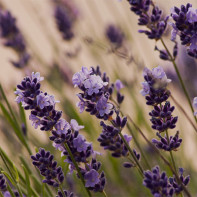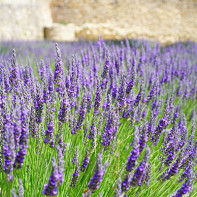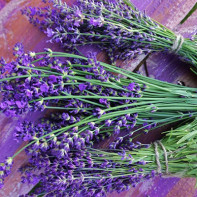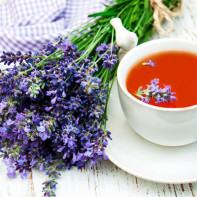Lavender: therapeutic properties and contraindications
When the word "lavender" is uttered, emotions run through the mind of anyone who hears it. One conjures up memories of his grandmother's old chest of drawers, lurking in a corner with a sachet of that delightfully scented herb. For another, the view of the endless blue-violet plantations, seen somewhere in a book or even on a trip, flashes before his eyes. And the third simply begins to hum, "Lava-a-nda, mountain lava-a-nda...". This plant is truly legendary.
- Chemical composition
- How it looks and where it grows
- Types of
- Gathering and storage
- How sage differs from lavender
- Therapeutic properties of lavender
- For Women
- For Men
- If Pregnant
- Breastfeeding
- For children
- Slimming
- Lavender in traditional medicine
- Lavender herbal preparations
- Infusion
- Tincture
- Decoction
- Tea
- Salve
- Syrup
- Lavender oil: properties and application
- Cosmetic use
- For neck rejuvenation
- For firm skin
- For strong nails
- For tender hands and healthy nails
- For Face
- Wrinkle Face Mask
- Acne Treatment Mask
- For Dandruff
- Hair Growth Mask
- Lotion
- Lavender in cooking
- Lavender sugar
- Lavender Vinegar
- Lavender Lemonade
- Lavender Chicken
- Lavender in daily life
- How to grow lavender at home
- How Lavender Honey Benefits
- Contraindications for use
Chemical composition
The pleasant, recognizable smell of lavender is due to the essential oil, which is found in all parts of the plant, but most of all in the inflorescences - up to 5%. It is mostly because of the oil that lavender is valued, which is why it is grown for its production. The essential oil of lavender is a complex of derivatives of various acids, which not only in combination but also separately are substances that are beneficial to the human body.
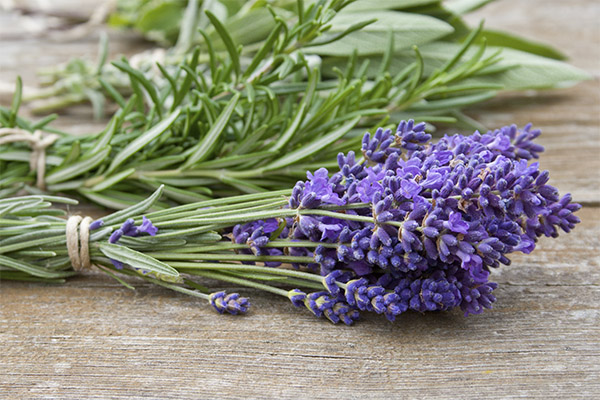
So, its constituent ursolic acid can provide an increase in muscle volume, keep metabolism and blood sugar under control and fight excess weight. In addition, this component of lavender inhibits the reproduction of malignant cells.
Valerian acid is responsible for heart function, capronic acid plays anti-inflammatory and blood-stopping roles. Antiseptic and expectorant action is characteristic of cineole, a substance with camphor odor. Citral works as an antiseptic and anti-inflammatory; it also has the ability to lower blood pressure. Lavender oil also contains tannin, a well-known tannin that has long been used in medicine as an antidiarrheal and anti-hemorrhoidal weapon.
In addition, lavender contains a whole complex of fragrant substances used in perfume manufacturing - geraniol, borneol, coumarin, garnierite, amyl alcohol, lavandulol.
What it looks like and where it grows
Botanists classify lavender as a semi-shrub - that is, a plant whose stem is woody underneath and herbaceous on top. A perennial evergreen herb usually grows to a height of 50 to 70 cm but sometimes up to 80 cm. It can grow to between 700 and 800 stems which make it a sprawling, fluffy, attractive plant and a favourite of gardeners.
From a distance the young sprouts look a bluish grayish color because their long, fine lanceolate leaves, wrapped around the edges, are covered with the finest hairs which give them that color. Older leaves take on a richer green color, but their pubescence remains - at the bottom of the leaf. The leaves may be both serrated at the edges and even, and they sit on the stem in pairs - one against the other.
But when the plant is in bloom, which begins in June and lasts until August, the leaves are inconspicuous. The bush itself takes on a fascinating blue or bluish-purple color due to the numerous flowers gathered in narrow, tetrahedral inflorescences in the form of a long, narrow spike. Lavender comes in white, pink and purple, but these are mostly bred varieties, its natural color is still in blue tones.
Each individual flower is small, no more than 1 cm, has a double-headed shape. When it blossoms, it turns into a small fruit, consisting of four small brownish-brown nuts. The seeds usually mature by September.
Its root is strong and woody and can penetrate many meters into the ground.
Its natural habitat is the southern parts of Europe, the Mediterranean coast, the Canary Islands, northeast Africa, India, Australia and the Arabian Peninsula. In Russia this fragrant plant is fond of the Caucasus, more precisely - its Black Sea coast. Lavender prefers to settle in mountainous areas, but thanks to its long root it is also able to extract water in dry places.
Despite the plant's southern origins, gardeners in more northern areas have adapted to growing it in their plots: some in the open air, learning to create suitable conditions in winter, some as a potted crop, planting it in the country house only in the warmer seasons.
As a crop of economic importance, lavender is grown in whole plantations in southern Europe - Italy, France, Spain.
Types
Today there are about 50 varieties of lavender known, grouped into 6 main groups. At the same time 4 groups are used for perfumery or medicinal purposes.
The most widespread species is the narrow-leaved lavender. Its inflorescences are used for medicinal and perfumery purposes. It is native to the western Mediterranean and is found in mountains up to 1500 m above sea level.
The broadleaf lavender is native to the Balkan Peninsula, Italy, Spain and France. It has not learned to climb as high into the mountains as its narrow-leaved relative. It has two characteristic features: Not only the stems but also the flower stems branch and the leaves smell of camphor.
The intermediate lavender is a result of a natural cross between the narrow-leafed and the broadleafed variety. And from it you can get twice as much essential oil. This has been noted by humans and through artificial crossbreeding they have created varieties that are now grown for oil on an industrial scale. This is still in its camphor smell and as such is worth only half as much as the narrow lavender oil. It is chiefly used in the home.
The name 'lavender woolly lavender' speaks for itself because the leaves have a dense coat of hairs. It is very susceptible to rain and moisture and will die if the soil becomes wet.
French lavender has inflorescences of dark purple color, it is quite loyal to moisture, so it is suitable for growing somewhere in the lowlands.
Harvesting and storage
To begin saving lavender when it has had more than half its flowers in bloom because this is the time in its life when it has stored the maximum amount of essential oils. This period is easy to guess because the color and scent are at their strongest. This is usually the period from mid-June to the end of July.
For decorative purposes and dry bouquets in winter the lavender should be cut earlier so that it is in the bud stage when the essential oils are still lacking. Then the fragrance is not too strong and overpowering. This is also when lavender is being plucked for cooking.
As with any other herb, lavender must be gathered in dry weather and it must not have been raining for two to three days. It is best harvested in the morning after the dew has dried. Do not wait for the midday heat, because then the essential oils from the plant begin to escape.
Use a sharp secateurs or scissors to cut off the top part of the stem with a flower stalk - about 20 cm. Do not break off branches with your hands - you can hurt the plant.
Then the cut material in the form of bunches is hung under the ceiling of the veranda, in the attic, where there is a draught, or in a hay barn, where they can not get solar rays and moisture. If the inflorescences are few, you can not hang them but dry them in an unfolded state. Inflorescences of different colors-white, blue, or pink-must be dried separately to preserve the clean, bright hue of each.
To store dried lavender choose cardboard or plywood boxes with holes for extra ventilation. You can put dry raw materials in bags of cotton fabric and put in a closet - the herb and will be well preserved and play the role of a sachet.
If the plant is properly harvested and stored, the smell and beneficial properties will remain unchanged for many years.
How sage differs from lavender
Both lavender and sage are native to the south. They both like about the same type of soil and sunshine and both are used in perfume manufacturing. But there are a few differences.
- Firstly, the smell. Lavender is said to have a "thick astringent scent" while sage has a spicier, fresher, richer scent with a hint of pine or ambergris.
- Second, the stem. Lavender has a completely smooth stem, while sage has white hairs and is even called woolly.
- Third, the leaves. Lavender leaves are all the same - small and sessile. Sage has two types of leaves: the lower ones are on petioles and the upper ones are sessile. And the size of the sage leaves is larger.
- Fourth, the inflorescences. Lavender has a thin, long and fairly dense spike, while sage's are branched and looser in appearance. And the flowers of sage are much larger.
But both lavender and sage are equally beneficial to humans.
Therapeutic properties of lavender
The incredible medicinal value of lavender has been scientifically proven. Medicine has nowadays documented its positive effect in treating 167 ailments.
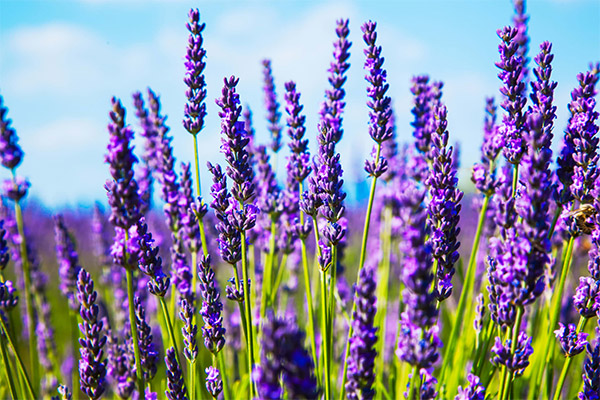
Lavender based formulas have soothing, toning, anti-inflammatory, antibacterial and analgesic properties. The plant is used to treat diseases of the digestive system, relieves migraine headaches, brings high blood pressure in order, calms the nervous system and relieves depression. Lavender flower tea is no problem with any stress, it is wonderful for insomnia, providing a quick fall asleep and a peaceful, restful sleep.
Lavender oil alleviates joint pain, is used to heal burn wounds and to relieve itching after an insect bite. A soothing massage with this remedy is effective in the most difficult and neglected cases, when you need to relax muscles, relieve general tension and even soothe a headache.
For women
For women, lavender can be a kind of friend, because with this plant is easier to endure stress, depression, nervous breakdowns. If you need to calm the nervous system, the first assistant is lavender.
Lavender oil can help and delicate women's problems: cystitis, gynecological diseases. Lavender oil, thanks to its antiseptic properties, quickly copes with inflammation and relieves pain. To solve such a problem as thrush, do sprinkles chamomile infusion with the addition of lavender essential oil.
In addition, lavender helps to normalize the menstrual cycle, eliminating disturbances of the hormonal background.
For men
Men - lovers of fatty foods, alcohol and cigarettes, as a rule, have high blood cholesterol, which can lead to early stroke or heart attack. To minimize these risks will help lavender preparations, they have a beneficial effect on the cardiovascular system, purify and revitalize the body.
In addition, lavender oil - a natural aphrodisiac, it helps in cases of reduced potency. And the calming ability of lavender not only normalizes the nervous system, removes irritability and aggression, but also gives self-confidence.
If you are pregnant
Is it acceptable to use lavender during pregnancy? There are different opinions on this matter. Some experts argue that lavender is unacceptable while waiting for a baby. Others believe that the moderate use of its compositions does not carry any threat. But both agree on one thing: the preparations with this plant is better not to take it internally. This is especially true in the first weeks of pregnancy, since lavender stimulates the contraction of the uterus.
If you want to eliminate nausea with toxemia, relieve irritability, restore normal sleep, you can resort to external use of lavender, for example, take a bath. And it is better not to buy ready-made oil, and prepare a homemade decoction of dried flowers of the plant.
Ready-made oil can be used for a massage if the back pain in the last weeks of pregnancy, dropping a couple of drops in massage oil. If you add the same couple of drops of lavender oil to the olive oil, you can rub this mixture into the skin of the abdomen and massage the legs, which will have a preventive effect from stretch marks and varicose veins.
Breastfeeding
During breastfeeding, compositions with lavender are allowed only for external use. Breastfeeding mothers can take massage sessions with lavender oil, they will help lose weight and bring the body back to normal after childbirth.
Baths with lavender decoctions are also acceptable to relieve stress, to keep the nervous system in order. If during pregnancy due to hormonal restructuring the skin of the mother suffered, baths and washes with lavender will restore its former attractiveness.
For children
Pediatricians say that the internal use of lavender in children under 12 years is best excluded. Later it is possible, but first making sure that the child is not allergic to it. It should be borne in mind that lavender oil is not recommended for boys who have entered puberty, because it can make adjustments in the formation of hormonal background.
Lavender is good for children in the form of baths, it helps to relieve agitation, soothes and promotes restful sleep. It relieves the condition of babies suffering from diaper rash or dry skin. You can also use compositions with lavender in children in the form of inhalations to treat runny nose and cough for colds.
For weight loss.
Lavender has been recognized for its ability to combat obesity and help get rid of excess weight. It can be used in the form of baths, massage treatments and wraps. You need to add decoction to the baths, and use essential oil for massage and wraps.
In addition, when dieting will be useful to eat 2-3 drops of lavender oil every day, adding them to honey or dairy products. Undiluted oil should not be taken internally - it can leave a burn on the mucous membranes.
Lavender in traditional medicine
Folk medicine has long appreciated the therapeutic properties of lavender. The compositions created on the basis of lavender, and take the inside, and make them compresses, lotions, inhalations, baths. The lavender plant's flowers and shredded herbs are used in the preparation of medicines.
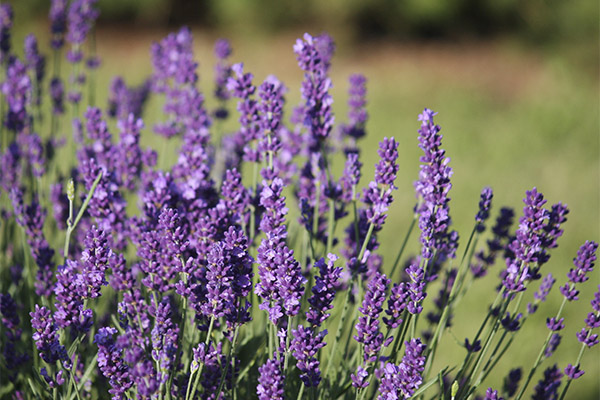
Lavender inhalation is good as soon as your throat is scratchy or you have a cough. Do not wait until the ailment begins to worsen, it is better to immediately drop 3 drops of oil in a glass of water, heat it to 50-55 degrees, and then, bending over the solution, cover your head with a large towel, so that the agent is not atomized idly, and breathe this healing steam for 5-7 minutes.
Baths with lavender oil are of great benefit to the nervous system. They can relieve stress, calm, lift your spirits, regain interest in life and cleanse your skin, heal all the wounds and cracks, rejuvenate, refresh. All it takes is 5 drops of oil. And in case of inflammation, itching and swelling in the place of insect bites, you need to rub the skin several times a day with any composition based on lavender.
And often to solve one problem, folk medicine offers several uses for lavender: Thus, for headaches and migraines you can take a therapeutic bath with essential oil, drink warm tea of dried flowers, light an aroma lamp and heal yourself while enjoying the lavender fragrance.
Lavender Healing Compounds
Lavender infusion .
- For increased fatigue. Pour one tablespoonful of each flower in 2 glasses of boiling water. Infuse for two hours with a blanket over it. Infusion strain and take. Daily rate - four times a day for a quarter cup half an hour before a meal.
- A biliary infusion. 3 teaspoons of flowers and 400 ml of boiled water heated for 15 minutes in a water bath, while keeping the lid closed. Remove from the bath and infuse for 45 minutes. Infusion strain and take this remedy for half an hour before a meal and 100 ml.
- With tachycardia. 3 teaspoons of flowers pour 400 ml of boiled water and heated for 30 minutes in a water bath, stirring from time to time. Remove from the bath and infuse for 10 minutes. Infusion strain, divide into equal portions and drink during the day in several stages.
- Bath from sweating feet. Lavender has the property to regulate sweating, which is used if the feet sweat a lot, and, as a consequence, smell unpleasant. In such cases, useful baths are indicated. To make them, you must first prepare an infusion: take 20 grams of dried mixture of lavender and sage and pour 0.5 liters of boiling water. Infuse and after 30 minutes, strain. For greater effect drop in this infusion of lavender (5 ml) and sage oil (3 ml). The resulting composition to pour into a bowl with hot water and steam your feet for 20 minutes. Repeat the procedure several times a day.
Tincture .
Recipe for migraine: 3 teaspoons a good handful of flowers pour 0.5 liters of boiling water in a thermos. Insist for an hour. Strain, divide this amount into several parts and drink it all in a day.
Decoction
Lavender decoctions can be taken internally as well as taken in a bath.
Therapeutic lavender bath
Pour 60 grams of flowers in a pot with 1 liter of water, over low heat bring to a boil and remove from the stove. After 10 minutes, strain. Pour the decoction into a bathtub filled with water. It can bathe a child if it's time to sleep, and he was very excited. Such a bath can also be taken by an adult to increase vitality or relieve any skin irritations.
Tea
Lavender tea in the evening will calm the nerves and put you in a good sleep. Tea with a slice of lemon is ideal for colds.
Tea for insomnia
Pour a glass of boiling water 2 teaspoons of flowers with a handful. Insist like normal tea, no longer than 10 minutes. It is better to drink it an hour before going to bed.
The ointment
Lavender ointments can be applied to the temples for migraines, to treat skin irritations, acne and burns. The healing plant is also used in this form to relieve symptoms of rheumatism.
Salve for dry eczema
0.5 liters of olive oil with two tablespoons of lavender flowers to keep on a water bath for 2 hours. After insisting for about 10 hours. Keep such an ointment for a month and a half.
Syrup
Lavender syrup is always good. If someone in the family got wet feet and caught a cold, someone has a sore throat, a migraine, an alarming and more often than usual heartbeat, no appetite - these problems can be solved by taking a teaspoon of syrup for 30 minutes before a meal.
Lavender syrup
Syrup is easy to prepare: boil for 20 minutes in 2 liters of water and 2 kg of sugar, 100 grams of lavender flowers. After 24 hours, strain the syrup and can be stored in a jar of dark glass.
Lavender oil: properties and uses
Lavender essential oil is obtained from freshly harvested plants. The flowers contain the most oil, the leaves and stems a little less, but they are also quite suitable for extracting the healing agent from them.
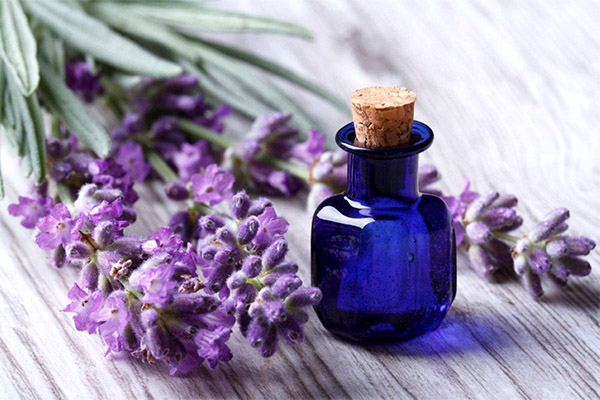
The plants are heated in a water bath, which splits their structure and turns the flower essence into vapor. The vapor is collected and cooled, causing it to precipitate as condensate and essential oil, flowing into one common container. It is not difficult to collect the oil from the surface of the condensate. This process is called steam distillation.
True lavender essential oil is colorless, sometimes it can be either yellow or light green. This product is afraid of the sun, so store it in a dark glass container.
To verify if the oil is really natural, you can drop it on a white paper. A natural product should not leave a grease stain after evaporation. It is characterized by a sweet and tart flavor with a hint of bitterness. The finished product is rich in useful substances - limonene, aldehyde, tannins, linalyl acetate, coumarion, valerian and butyric acids.
The essential oil of lavender is known for its broad range of action, which allows its use in both medicine and cosmetology. It is able to fight bacteria and viruses, relieve cramps and spasms, have analgesic, diuretic and sedative effects, improve heart function and blood flow, including in the brain, reduce blood pressure.
Because of such a rich set of useful properties, it is used by therapists to treat acute respiratory infections, sore throat, pneumonia. With its help increase immunity, stabilize the nervous system, normalize sleep, speed up the treatment of depression, get rid of headaches. Lavender oil is effective for elimination of palpitations, rheumatism, paralysis.
With the use of the oil, wounds, burns and other skin injuries heal faster and without traces. It improves blood microcirculation in the skin, relieves its redness, itching and flaking. Because of the ability to clean and rejuvenate the skin oil has become the No. 1 tool in cosmetology, including in the care of the hair. The oil is also used by gynecologists to treat women's problems.
Cosmetic applications
Lavender is by far the number one herb in cosmetology because it can be used with almost any cosmetic problem. Its cosmetic applications are so wide that it is able to cure allergies and irritations. Thanks to its anti-inflammatory and antiseptic properties, lavender is successful in the treatment of acne, after which there is not even a trace and scars are smoothed. By regulating sebum production and its ability to shrink pores, it prevents the appearance of new blackheads.
Lavender also improves circulation and smoothes wrinkles. Lavender oil is used in wrap formulations, using its anti-cellulite properties. It not only cures and nourishes the skin, but also strengthens the hair and nails, and successfully copes with the treatment of dandruff.
Decoctions and oil infusions of dried lavender raw materials and essential oil are used in cosmetology. And, the essential oil itself is so concentrated that it can cause burns, it can only be used as a supplementary component with other substances - oils, creams, etc. When preparing homemade beauty products, remember that lavender is a kind of conductor, which helps these basic creams and oils to penetrate deeper into the skin, so they must be of impeccable quality. If lavender oil is heated slightly before use, this will enhance its therapeutic effect.
To rejuvenate the neck
A woman's age is often not as visible on her face as it is on her neck and décolleté, which is where you often see early wrinkles. Lavender oil can smooth and rejuvenate the skin. For this procedure, you need to mix two tablespoons of honey with two drops of essential oil and apply this mixture for half an hour on the upper part of the chest and neck.
For firm skin
The fight against cellulite sometimes turns into a long and fruitless for women. Lavender not only successfully cures the problem, it also tightens the contours of the body, has a rejuvenating effect and prevents stretch marks. For this purpose, lavender oil is added to the oil used for ordinary massage: 5 drops per 10 ml of massage oil. In combination with lavender baths this procedure works especially effectively.
For Strong Nails
To make your nails stop splitting and become strong, you need to rub a drop of lavender oil on each nail plate for a minute every day. This way the cuticle will be softer and the nails will have a healthy shine.
For soft hands and healthy nails
Dissolve a spoonful of sea salt in 250 ml of water and drop in 10 drops of lavender oil and use this mixture as a hand soak. After 15 minutes, take the hands out, dry them with a towel and apply cream.
For the face
Drop 2 drops of lavender oil in a bowl with 2 spoons of olive oil. Stir and apply to face. After 20 minutes, rinse off with clean warm water.
Face Mask for Wrinkles
Heat a spoon of honey on a water bath, remove from the stove, add to it whipped egg white, 50 g of yogurt, 3 drops of lavender oil, mix. Put the mask on face for 15-20 minutes. Then wash your face with slightly warm water.
Acne Relief Mask
Whip an egg yolk, add a couple of drops of essential oil, mix. Spread the mixture on the face and lie still for 15-20 minutes. Then rinse the composition with clean water.
From dandruff
In the amount of shampoo, which is enough for the usual washing of the head, drop 3-4 drops of lavender oil. Then proceed as usual.
Mask for hair growth
So that the hair grows well and dandruff no longer tormented, mix 3 drops of lavender oil and 2 spoons of burdock oil, distribute the mixture throughout the hair and rub into the scalp. For 40-50 minutes wrap your head with polyethylene and a terry towel for warmth. Such a mask is well washed off with shampoo.
Lotion
Shake 100 ml of glycerin, 150 ml of water, 100 ml of good vodka and 10 drops of lavender oil in a bowl. Use to wipe the skin in the morning and evening.
Lavender in Cooking
If you look at lavender only as a medicinal, perfume or cosmetic, it will not be quite right. For Russian cuisine it is a wonderful, but so far unfamiliar lady. And in the arsenal of French, Spanish and Italian hostesses have many culinary recipes in which this plant is used. In the Mediterranean countries dried lavender flowers are ground into a powder and sprinkled on ready meals, like pepper. In Hungary they even make lavender ice cream.
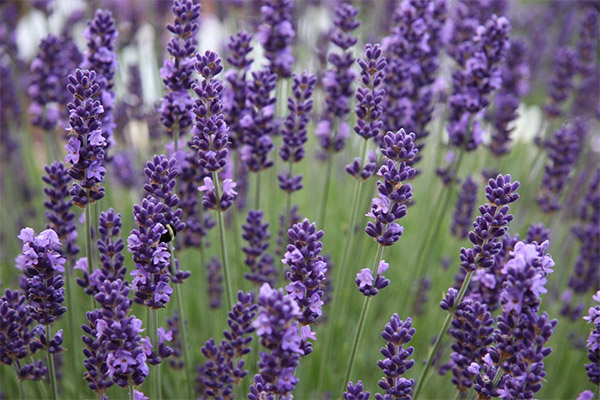
It can be added to sauces, soups, desserts and even meat and salads and its aroma proves very useful. Meat marinated with lavender and rosemary has become one of the most common European dishes. The combination of honey and lavender is already considered a classic of haute cuisine, in such a collaboration they are used in pies, baked with it cookies and bread, cooked jellies and jams, added to cottage cheese. But you need to use lavender very carefully, in small quantities, otherwise the aroma will spoil the whole dish.
Lavender sugar
Put 3-4 lavender flowers in a sugar bowl, and after a day lavender sugar will be ready. It will take on an interesting smell and will help bring variety to the evening tea party.
Lavender Vinegar
Throw 5-6 dried lavender flowers in a half liter bottle of vinegar. Let this soak for a week. The vinegar will absorb the lavender flavor and will be a tangy addition to a salad or dressing.
Lavender Lemonade
To make 1 liter of lemonade, 1 teaspoon of dried lavender is enough. Pour a glass of boiling water over it, stir in 5 tablespoons of granulated sugar, and strain when cool. Squeeze the juice of a lemon into it. Cut a second lemon into small pieces. Pour crushed ice, chopped lemon, and lavender broth into a beautiful pitcher. Pour in 750 ml of sparkling water.
Chicken in lavender
For the marinade, take 1 tablespoon each of rosemary, thyme, the juice of half a lemon, 2 tablespoons each of olive oil and honey, 1 teaspoon salt and half a teaspoon of lavender flowers. Marinate 1 kg of chicken fillets for a couple of hours, then send it to the grill.
Lavender in the home
Due to its pleasant smell, lavender essential oil is widely used in the home. Even our grandmothers used to keep a small sachet of dried lavender in a corner of the dresser, a tradition which has safely survived to the present day. Such a sachet impregnates floral fragrance all that is stored on the shelves. Especially pleasant to sleep on such bedding. The second problem that can be solved in this way is to banish moths from the closet.
In addition, the disinfecting properties of lavender oil are used today in the home, for which it is often added to the washing machine when washing. In order to aromatize and disinfect the air, a cotton pad soaked in oil is placed in the bag of a vacuum cleaner.
Get rid of unpleasant odors from the refrigerator or kitchen cabinets will help wipe them with a sponge, which dripped essential oil.
If you ignite the house aroma lamp with lavender, you can not only fill the house with a pleasant smell, but also get rid of mosquitoes and flies. And if you put a dry lavender bouquet in a vase in winter, a light aroma in the house will be assured for a long time.
How to grow lavender at home
Many people would like to have a little piece of the Mediterranean in their windowsill, if only in the form of lavender. For many years it was thought to be impossible to grow it at home but an avid lavender lover has learnt the secrets of growing it indoors. The main thing is to carefully control the temperature and fulfill all the "whims" of the beauty.
The pot for planting lavender should be taken at least two-liter, its diameter should be 30 cm. At the bottom lay drainage, you can use expanded clay, small pebbles or nutshells, prepare loose sandy soil of alkaline reaction.
For the plant suitable windowsill, where there is enough bright sunlight, otherwise it will die. Frequent watering is detrimental to lavender, enough watering once a week, and in the autumn rainy season, when the air is high in moisture - once every 10 days. In the winter the lavender can be pruned a little and placed in a cool (but not cold) place. It only needs to be watered about once in two weeks.
To keep lavender happy for a long time, it needs regular fertilizing, you can use those fertilizers that are usually used for houseplants.
When the root of the plant reaches the day of the pot, you need to transplant it immediately so that it does not become diseased. Choose a pot with a larger diameter, and then follow the usual rules for transplanting plants. By the way, fans of lavender noted that in light pots it grows better than in the dark, because the dark attract more sunlight, and the soil is strongly overheated, and this harms the roots.
How is lavender honey useful?
There are two types of honey called lavender honey. The first is natural, collected by bees from lavender plantations. It is rare, not cheap, and its folk medicine appreciates it very highly. The second is honey mingled with lavender and heated with regular honey. This honey is similar to the natural honey only in smell, but lacks the medicinal qualities of lavender.
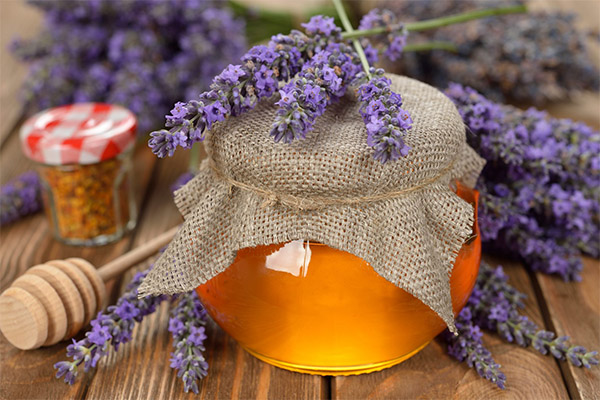
Natural lavender honey is very beautiful. The fresh, recently harvested product literally sparkles and shimmers, like a melted golden ingot carrying a lavender aroma. It tastes sweet, but not sugary. The honey does not crystallize for up to three months, but when it does, it takes on a white color and becomes like cream.
Lavender honey itself can serve as a soothing agent. The fact that it contains a large amount of an amino acid called tyrosine, which has a beneficial effect on the brain. In medicine, this feature is used to treat pathologies of the nervous system - stress, depression, Alzheimer's or Parkinson's disease. It also helps to cope with chronic fatigue syndrome.
Honey is also excellent for people who have been weakened by serious illness or surgery, and helps them quickly regain strength after difficult mental tasks. Despite the fact that it is a sweet product, it reduces blood glucose levels, as well as reducing the amount of cholesterol.
Honey has taken all the good properties of lavender, as a result of which it is useful for improving memory and stimulating brain activity, as well as for weight loss, because it speeds up metabolic processes in the body, for cleansing of toxins and waste. Honey helps to heal wounds, scrapes and burns in the mouth, kills viruses and other pathogens, as well as beneficial effects on digestion and heart and blood vessels.
Contraindications for use
As a rule, neither dried lavender nor lavender oil does not cause obvious allergic reactions, but still there are cases of its individual intolerance. Lavender is contraindicated in all such cases.
Lavender should not be consumed by pregnant or breastfeeding women or children under 12 years of age.
Lavender has good choleretic properties, and this can be harmful to people suffering from diseases of the gallbladder associated with the violation of its motility and the presence of stones. If the stomach acidity is too high, it is not advisable to eat lavender because it can cause heartburn. Because lavender has the ability to lower blood pressure, hypotensive people should not eat it. You must also avoid lavender if your doctor prescribes iodine.
It will only do you good if you follow the advice and do not exceed the prescribed limits. If you exceed the norms, there may be side effects such as weakness, nausea, palpitations, dizziness, sweating, chills and even seizures.
«Important: All information on this site is provided for informational purposes only. for informational purposes only. Before applying any recommendations, consult a health care professional. specialist. Neither the editors nor the authors shall be held liable for any possible harm caused by materials."

